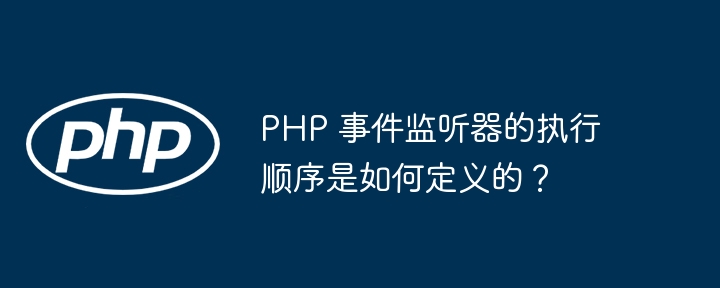
The execution order of PHP event listeners is determined by both the priority and the registration order: Priority: Higher values indicate higher priority execution (range is -10 to 10). Registration order: Listeners with the same priority are executed in the order of registration.

Execution sequence of PHP event listeners: explain in simple terms
Understanding the PHP event system
The event system in PHP uses event listeners to handle events. Listeners are registered by subscribing to specific event types. When the event is triggered, the system will execute the registered listener.
Execution order
The execution order of event listeners is determined by two factors:
Priority
The priority of the listener is set by thewithPriority()method, the priority value range is -10 to 10 , where:
By default, the priority of the listener is 0.
Registration sequence
Listeners are added to the event dispatcher through theaddListener()orsubscribe()method. The order of registration is determined by the order in which these methods are called.
Practical case
The following code snippet demonstrates a practical case of the listener execution sequence:
use Symfony\Component\EventDispatcher\EventDispatcher; use Symfony\Component\EventDispatcher\EventSubscriberInterface; use Symfony\Component\EventDispatcher\Event; class EventA extends Event {} class EventB extends Event {} class ListenerA implements EventSubscriberInterface { public static function getSubscribedEvents(): array { return [ 'event_a' => ['onEventA', -5], 'event_b' => ['onEventB', 1], ]; } public function onEventA(EventA $event) { echo "Listener A: Event A\n"; } public function onEventB(EventB $event) { echo "Listener A: Event B\n"; } } class ListenerB implements EventSubscriberInterface { public static function getSubscribedEvents(): array { return [ 'event_a' => ['onEventA', 5], 'event_b' => ['onEventB', -2], ]; } public function onEventA(EventA $event) { echo "Listener B: Event A\n"; } public function onEventB(EventB $event) { echo "Listener B: Event B\n"; } } $dispatcher = new EventDispatcher(); $dispatcher->addSubscriber(new ListenerA()); $dispatcher->addSubscriber(new ListenerB()); $dispatcher->dispatch(new EventA()); $dispatcher->dispatch(new EventB());
Output:
Listener A: Event A Listener B: Event A Listener A: Event B Listener B: Event B
In this example,ListenerBhas a higher priority forEventA, so it is executed beforeListenerA. ForEventB,ListenerAhas higher priority, so it is executed first.
The above is the detailed content of How is the execution order of PHP event listeners defined?. For more information, please follow other related articles on the PHP Chinese website!